They Need a Little Structure
Last month, a reader posted a comment recommending a couple of articles she thought might interest me – one written by author/garden designer Rory Stuart and another by garden photographer Charles Hawes. Both were discussing issues related to garden photography and both gentlemen brought up the point that gardeners seem to want their gardens viewed (and photographed) only when they look their finest.
Rory Stuart writes, “Gardens are always hymns to time, and gardeners the leading choristers – “if only you had been here last week”, or “come again next week and they’ll all be out.”
Charles Hawes concurs, “Garden owners want their gardens to be seen at their best and are hungry for praise….the garden can never be praised enough and yet such praise never satisfies the owner.”
It got me thinking – why this need to apologize for the state of our gardens, even when complimented? If a garden is well designed, shouldn’t it look good all the time, and the gardener always feel good about his/her creation? In our harsh prairie/foothills climate, our gardens are perpetually one weather calamity away from near-destruction – late spring frosts, spring flooding, crazy hailstorms, early fall frosts, Chinooks, too-long winters, too-cold winters, too-warm winters with little or no snow. We must approach garden design in such a way that we can be pleased with our creations – no matter the season, or the weather.
I find myself apologizing on behalf of my front gardens much more than those in the back. The gardens in my front yard were created before “Sue-the-gardener” became “Sue-the-designer”, and though I’ve spent the better part of the last decade editing and correcting design faults, these gardens still lack overall structure. My back yard on the other hand, always looks appealing, always photographable. I don’t mean to suggest that it can compete with the great gardens of the world (the kind Mr. Hawes and Mr. Stuart would be referring to) – of course it can’t. It’s a simple low-maintenance residential landscape, designed to withstand the rambunctious play of boys and dogs. Though it looks different at various times of the year it never looks better. The design consistently fulfills its purpose with grace and elegance – even after a hailstorm. And I never feel the need to say, “Oh you should have seen it last week when such-and-such was blooming.”
Okay, maybe not never.
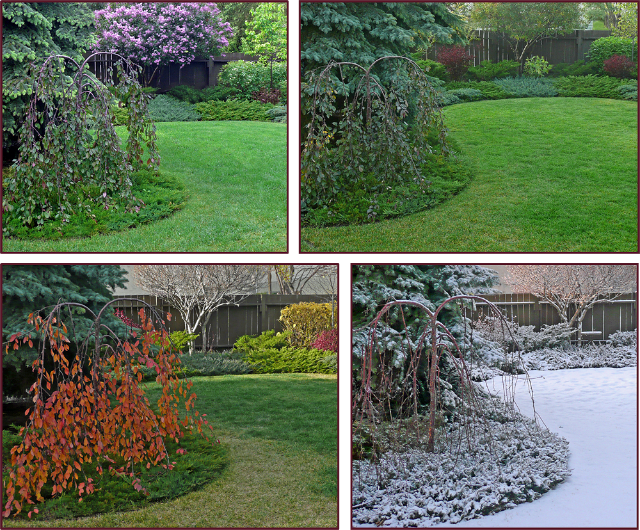
Two large adjoining arcs produce an uncomplicated but voluptuous curvilinear design. Low-maintenance shrub plantings highlight the design lines creating this attractive four-season view out my back window. Photos: Sue Gaviller
So what is good design? If you’ve been reading and following this blog you’ve learned the basic design process and the principles that guide it. Putting it all into practice – first on paper and then in your own garden – should yield some positive results. However, although a design is rendered on paper in two-dimensional plan view, a good designer must envision the end result in 3D. The garden in real space is a three-dimensional entity. It has a floor and walls and often a ceiling – paying attention to both the floor plan (Concept/Layout Plan), and the wall and window treatments (tree, shrubs and spaces between them), will help you focus on creating a solid skeletal structure that can stand up to scrutiny…and the weather.
Ground Plane – The Garden Floor
Good garden structure starts on the ground with your design lines, i.e. the shape of all your garden elements, including hard surfaces like patios and walkways and soft surfaces like planting beds and turf. Design lines must be strong in order to contribute to the strength of the overall picture – this means longer lines, fewer lines, and fewer directional changes, i.e zigs and zags, wiggles and waves. For some reason, gardeners assume simple means boring when really the simpler the line the stronger the design. (Check out Good Lines Mean Good Designs Part 1 and Part 2 for more info on design lines).

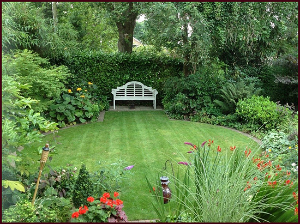
This backyard belonging to garden designer Mike Palmer, demonstrates lovely lines – indeed the strength of the design is in its simplicity, and affords the yard year-long beauty. Photos: Mike Palmer.
Hardscapes in particular are bold design delineators and will emphasize good (and bad) design lines. I find it very frustrating when clients contract my services after a poorly designed patio or walkway is already in place – there is only so much I can do with plants to mitigate poor hardscape design. These hard surfaces should therefore be carefully planned and constructed.
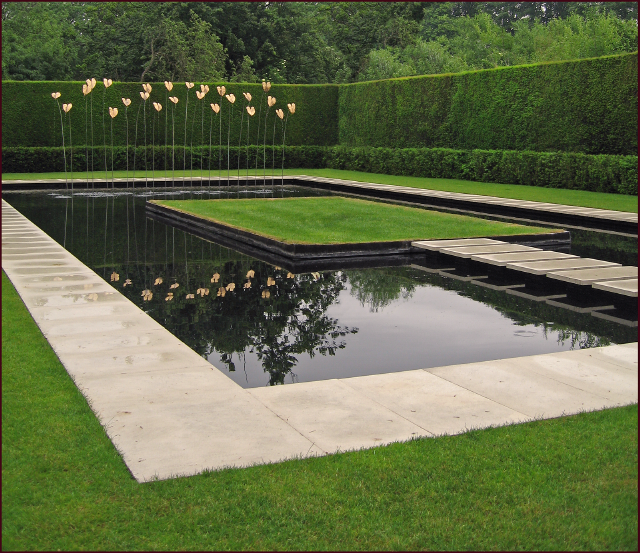
A concrete border and step-stone slabs emphasize the clean contemporary lines of a water feature at Kiftsgate Court gardens. Photo: Marny Estep
The garden floor also consists of living material; groundcovers and other low-growing perennials/shrubs – think of this as the “carpet”. Some landscapes have few, if any design lines – for example, a small front yard which is entirely planted and has no lawn or hardscaping, save a straight walkway. In the absence of design lines, plants alone must define the space, with flattish areas of groundcover and low growing plants serving as the ‘floor’.
In any case, keep in mind that whatever role plants play in your floor plan, herbaceous perennials die down at the end of the season so can no longer play their role. Make sure you include woody plant material, some of it evergreen, to provide year-long carpeting.
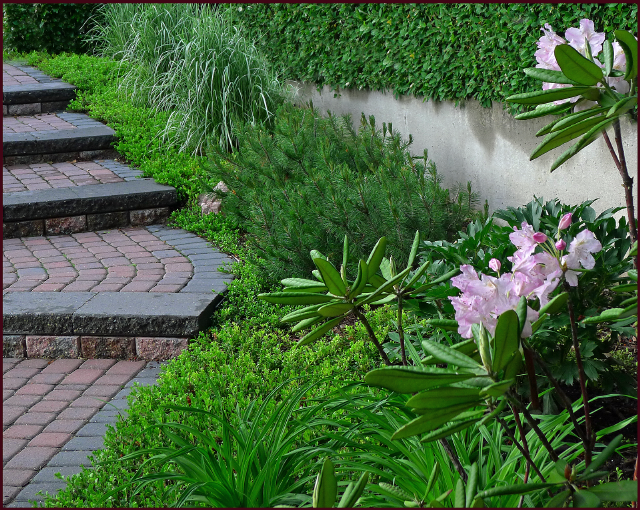
Low growing evergreens like dwarf mugo pine, kinnickinnick and Rhododendron make good 4-season floor coverings. Photo: Sue Gaviller
Vertical Plane – The Garden Wall
The vertical plane refers to upright elements in the garden, both walls and furnishings. Garden walls can be hardscapes, softscapes, or a combination thereof. Furnishings may be single accents (plants or focal points) or larger groupings of plants.
A hardscape wall is an actual wall – perhaps a courtyard wall, retaining wall, raised planter or fence. As with ground-plane hard surfaces, vertical hardscapes can be strong spatial definers, accentuating both good design and not-so-good – so remember simplicity is key.
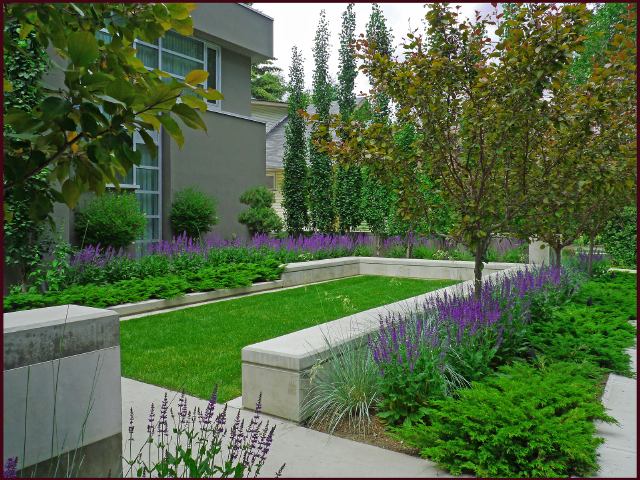
A low concrete wall outlines a simple rectangle, creating a very strong design. Linear plantings further strengthen the lines. Photo: Pat Gaviller
The role of garden wall can also be filled by plant material. These living walls can be quite variable in their effect – tall grasses suggest a softer kind of partition compared to the more sturdy presentation of woody shrubs, and a random shrub planting is less structured than the unyielding solidity of a clipped hedge. There are low walls, counter-height walls and full floor-to-ceiling walls, the function of which will determine how full, or how formal you want your wall to be, and what it will consist of.
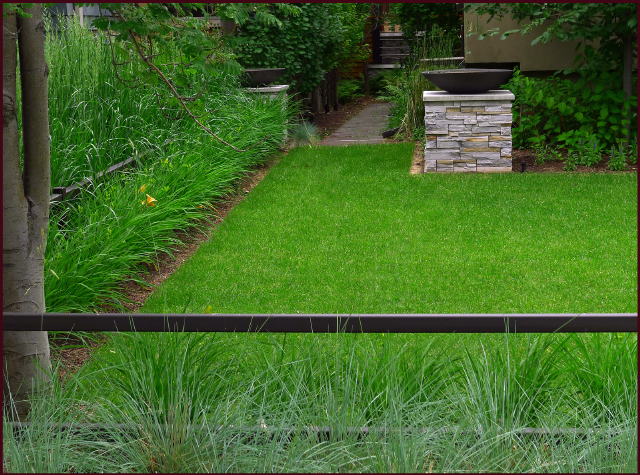
Grasses and daylilies softly delineate a property line with low iron railings and stone pillars providing more rigid structure. Photo: Pat Gaviller
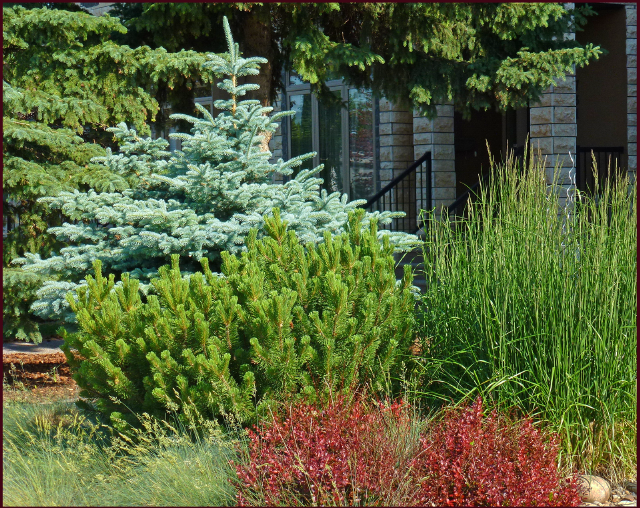
Evergreens, grasses and barberries contribute good structure to this landscape and provide a casual but effective wall between properties. Photo: Sue Gaviller
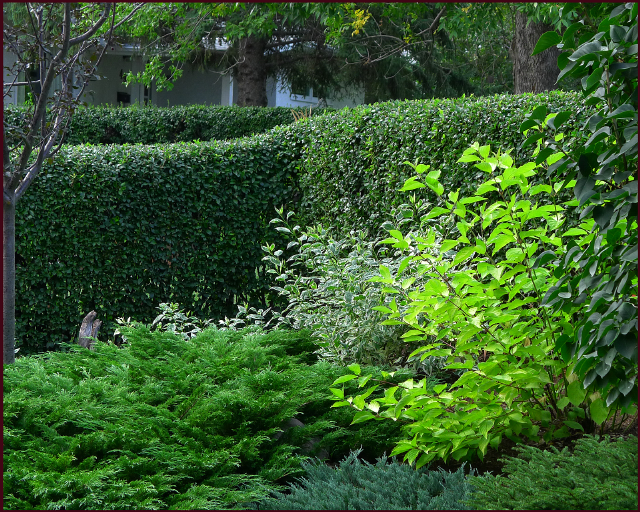
A clipped Cotoneaster hedge forms a casual, but very solid partition along a client’s property line. Photo: Sue Gaviller
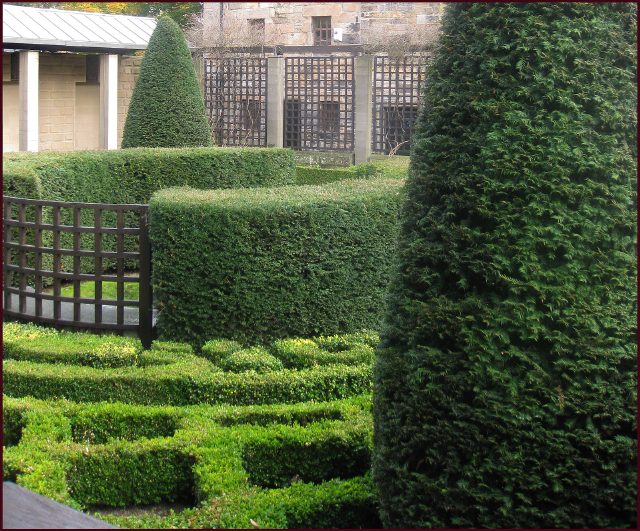
Perfectly trimmed hedges, upright evergreens, lattice fence panels and a brick wall provide formal walls in this old world courtyard. Note that here the low hedges or parterres provide flooring rather than walls. Photo: Evelyn Steinberg.
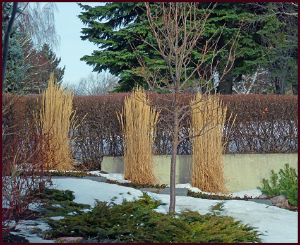
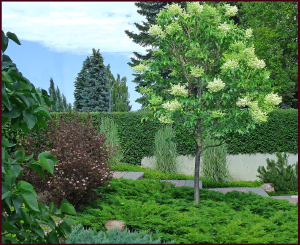
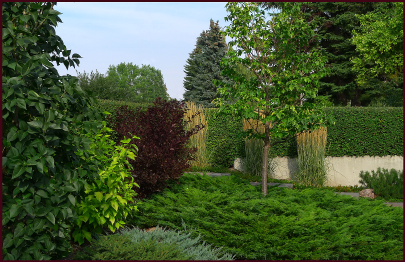
This client’s garden presents good structure year round – trees, shrubs, a Cotoneaster hedge atop a concrete wall, and tall grasses occupy the vertical plane and spreading junipers carpet the ground. Photos: Sue Gaviller
Overhead Plane – The Garden Ceiling
The garden ceiling is provided by overhead features like pergolas and arbours and by the branches of canopy trees. While a ceiling isn’t necessary for good garden structure it does complete a space and create more human scale – by capping the spatial height, vertical scale is reduced to more human proportions. This results in an intimate space that is cool and quiet by day and warm and cozy by night.
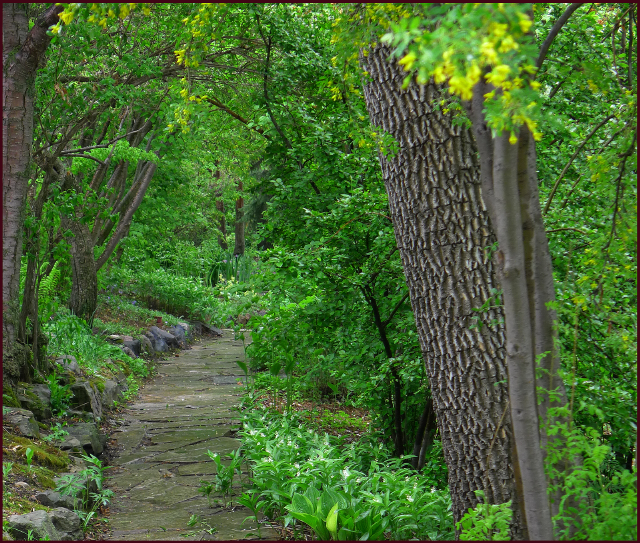
A cool, quiet path beneath the trees at Reader Rock Gardens. Photo: Sue Gaviller
An overhead presence also allows us to walk through to another space as though crossing a threshold – makes for some extra drama in the garden.
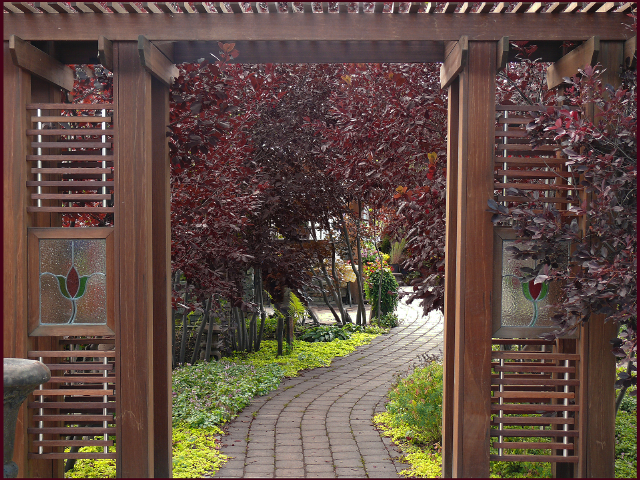
An arbour and canopied walkway provide a graceful entrance to Countryside Garden Centre . Photo: Sue Gaviller
In addition, the garden ceiling can provide protection from the elements; shade for our delicate skin and a ‘hail helmet’ for our delicate perennials – Hosta after a hailstorm looks like coleslaw.
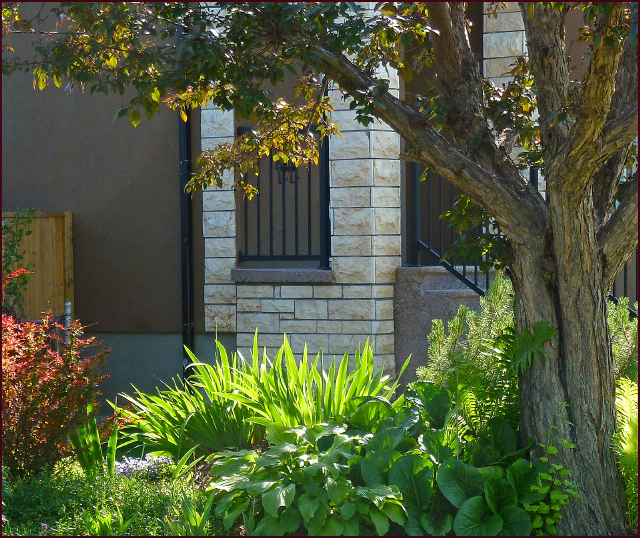
Coarse-textured perennials like Hosta and Bergenia are prone to hail damage. Situating them beneath a canopy tree offers some protection. Photo: Sue Gaviller
Earlier this week, as I was returning from a walk with Princess Pepper, I noted that my front gardens aren’t looking too bad, even in these barren winter months – deciduous shrubs, evergreens and ornamental grasses bring form, texture and subtle colour to the composition. More importantly they bring the garden some much-needed structure.
So the next time you find yourself impatient for the next wave of colour in your garden, or woefully observing how much better it looked last week, ask yourself, “What’s missing here?” Maybe it just needs a little structure.
Y’all stay warm, Sue © Sue Gaviller and Not Another Gardening Blog 2012. Unauthorized use and/or duplication of this material without express and written permission from this blog’s author and/or owner is strictly prohibited. Excerpts and links may be used, provided that full and clear credit is given to Sue Gaviller and Not Another Gardening Blog with appropriate and specific direction to the original content.Related articles
- Garden Photographs – some problems, by Rory Stuart (ThinkinGardens)
- A Photographer’s Response to Rory Stuart by Charles Hawes (ThinkinGardens)
- Good Lines Mean Good Designs (notanothergardeningblog.com)
- Curves Wonderful Curves: Good Lines Mean Good Designs – Part 2 (notanothergardeningblog.com)
- The Principled Gardener (notanothergardeningblog.com)